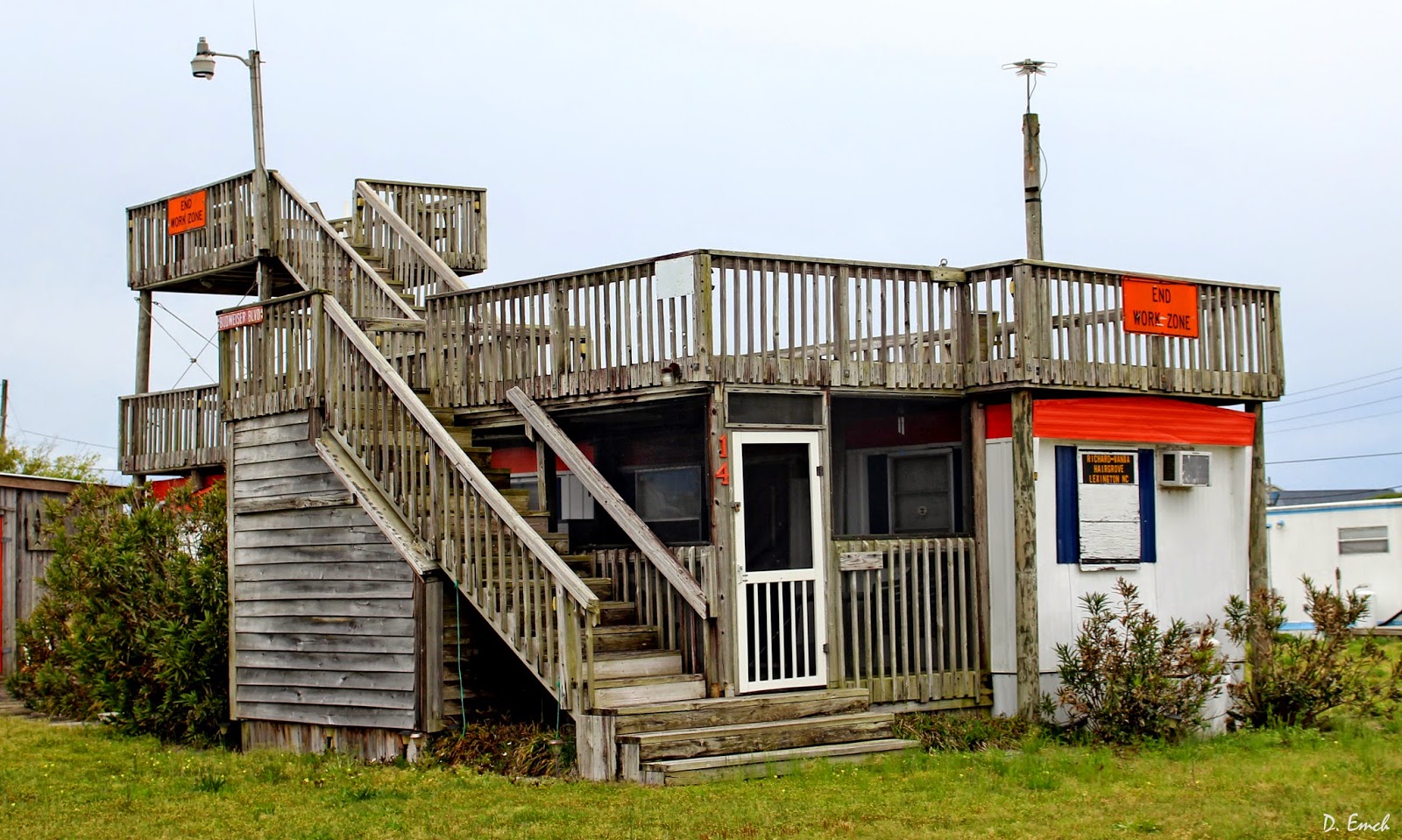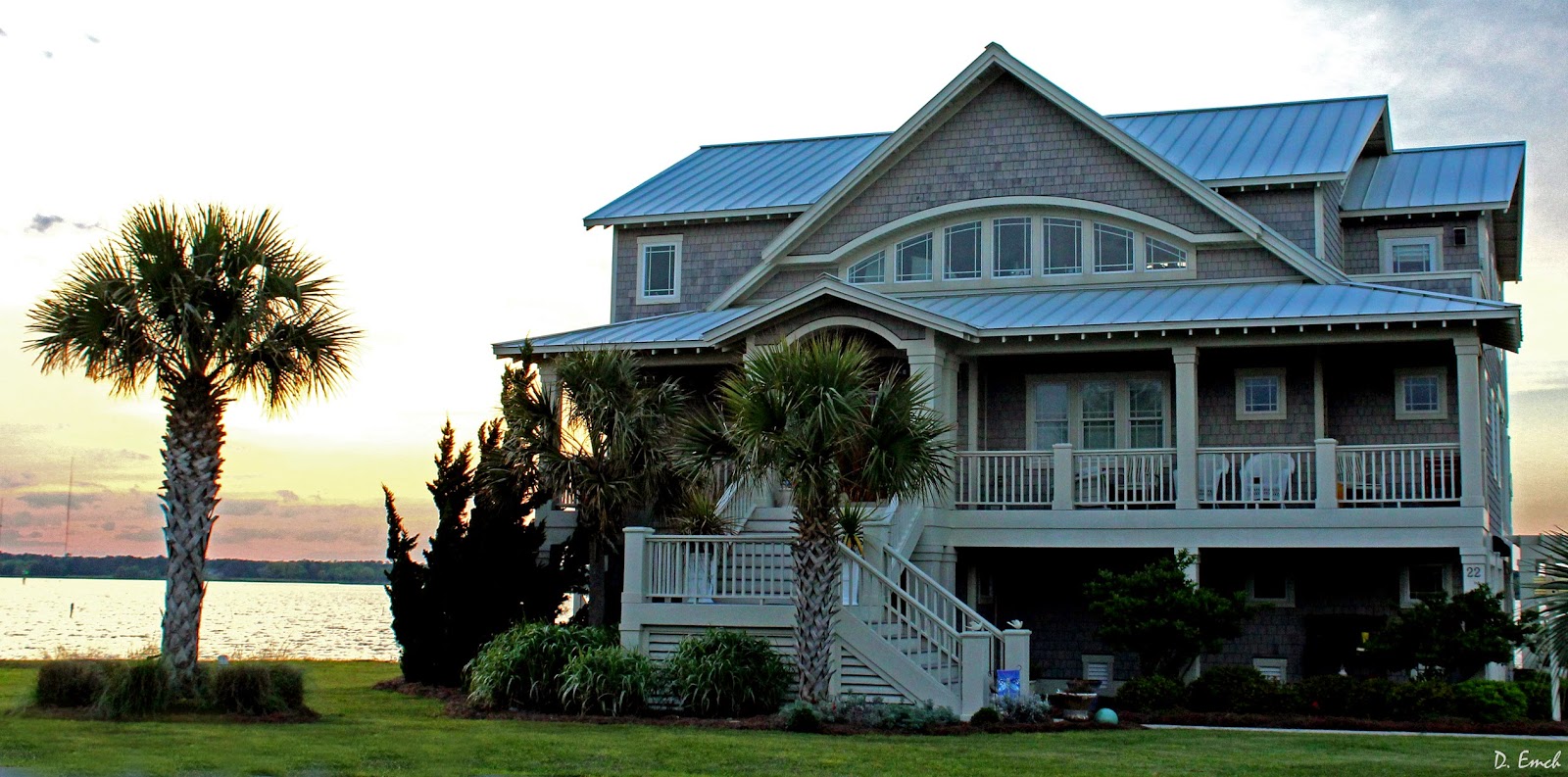Traveling about twenty five miles north of Wilmington and Wrightsville Beach, we arrive at Topsail Island. The island is just over twenty miles long, and perhaps a mile wide at its thickest point.
Folklore has it that the name harkens back to the 16th and 17th centuries when pirates were active in the area. Supposedly, pirate ships would hide behind the island, watching for likely prey to be moving along the coast.
Ships at sea would watch for the pirate ships behind the dunes - but all they could see was the top of the mast - hence the name "topsail."
There is an uninterrupted run of beach the entire length of the island, and the island itself is divided into three municipalities. Topsail Beach occupies the extreme southern end of the island, Surf City the middle and North Topsail Beach the upper end of the island. Much of the architecture on the southern two thirds of the islands is 1940's to 1990's, while much of North Topsail has been built in the last couple of decades.
A sound runs along most of the back side of the island, and the Intra-Coastal Waterway runs just inland along the full length. The main entrance to the island brings you into the heart of Surf City, but there is another bridge on the north end.
Many of the homes on the back end of the island are built right on the water. Many short canals have been dug into the backside, giving a lot more people access to deep water.
There are a few spots that have not been developed in this section, but they are steadily being built up. As you can see, the new construction is all going in on stilts - elevated ten to twelve feet to meet flood zone requirement.
We meet Howard Batts.
Howard Batts
Howard's grandfather purchased about a thousand acres of the island and just inland right after the civil war. Howard was born in 1939 - World War II broke out the next year. During the war the US Army took the island over. Howard says he is unclear if the owners were compensated for the use of the property, but he does remember a ceremony after the war where the government returned the land.
Howard says the people here were "land poor" - cash resources were scarce but there was an abundance of food. He recalls that for lunch his father would often pick a bucket of oysters and eat them along with bread. He recalls that shrimp was so plentiful that as a boy he could get several bucket fulls in an hour or so.
Some of his funnier stories revolve around alligators. When he was around eight years old, he went out to the outhouse early one morning, and as he was doing his business an alligator emerged from down in the latrine. Needless to say that made quite an impression.
His father started a cleaning business that turned into a going affair - they were running trucks to a couple of nearby military installations several times daily to transport laundry. They had a pet alligator they kept on a leash that disappeared one day. It turns out it had hibernated inside of a drainage pipe. It emerged into the shop one day covered in moss, sending workers into a panic about the "monster" that had emerged.
Just inland was the Army Camp Davis, pictured above. What the army wanted the island for was to practice anti-aircraft firing and to test a new generation of weapons - the RAM jet engine driven anti-aircraft missiles.
They had women - WACS - fly planes pulling drones that they shot at for practice. Howard says that he recalls that local women would go out by boat to retrieve the downed drones as the skins were made from a good sturdy silk, and fabric was hard to come by in this area.
A number of towers were built along the shore for observers to watch the outcome of the tests. These concrete towers still dot the shore.
All of the buildings and roads that the Army built became the property of the land owners when the Army pulled out, and they even left the bridge. Howard recalls that their first cottage on the island when he was a boy was an old converted barracks. His bedroom was huge, and had several other beds in it.
Well, his father and brothers decided to turn the chow hall into a dance hall and started hosting dances on the island every Friday and Saturday night, and they quickly became quite the local affair for military personnel from surrounding bases. At one point his father appointed himself "police chief" in an attempt to regulate activities. He wore a beret, put a "police" arm band around his sleeve and carried a revolver with no bullets.
The closest jail was 40 miles away, and his dad wasn't really the "arresting" type anyway. So Howard often woke up to other folks sleeping in his room - drying out a bit from the previous nights activities.
But the bridge ran across his grandfather's property, and hence after the war most of the early development was on their land. This is the middles section of the island, Surf City.
Most of the work assembling the missiles was done on the south end of the island - simply known as Topsail Beach.
Following is one of the earlier missiles being winched out of the warehouse they were assembled in to be test fired.
The missiles evolved over the years the army was here - following is a photo of one of the later models that could follow a radio beacon to guide it and then home in using its own radar when it got close to the target.
The building in the background of this photo was the "assembly building," where they put together the rockets for test firing. Today it is a large meeting center and a free museum that is well worth spending an hour or two at.
Sill later the RAM jet technology combined with improved explosives allowed a much sleeker design for the rockets. Here is a cut-away in the museum that shows the components.
Something else really worth seeing at the museum is a world class extensive collections of sea shells, most of which were donated by long time residents who were avid collectors.
There are many hundreds of shells, many of them of varieties I have never seen before.
One of the features of all three towns is a community pier. Topsail Beach wanted to charge me to walk out on theirs, so I didn't bother. I am not sure if the other communities charge or not.
But the fishing is good here. You can tell by looking most of the fishermen are seasoned.
All around town are photos of folks with trophy fish of various species.
One of the neat things about the island is that it serves as a living museum of beach architectural styles spanning 7 decades. Here are a few of the older "commercial" buildings that are close to the southern end.
I love the colors on the ice cream stand.
Now, I don't know my architecture that well, but I would say this cinder block house is 1950's, if it wasn't a converted military place built in the 40's.
This is certainly something that could have been built in the sixties - \maybe seventies.
I have seen "double wide" trailers before, I have seen "double high" trailers before, but this is the first "double decked" trailer I have seen.
There are a large number of hexagonal and octagonal houses, and even some with ten and twelve sides whatever you call them.
This one is actually pretty big. I think I counted 16 sides.
I am not what you call this style. Elongated silo maybe.
I gave up trying to figure out how many sides this next ones has.
I bet someone went through more than one pencil trying to draw the plans.
The most recent part of the island to develop is North Topsail Beach, thus it has many of the more modern homes.
This next one just looks like an excuse for someone to practice their deck building skills.
And a few are built right into the dunes on the beach.
But this is a barrier island, and the coastal environment is ever shifting. Below is a photo of what was the south end of Topsail Island just a few years ago.
An area that is accumulating sand is said to be "accreting." Well, as we have seen time after time on these coastal islands, when something is accreting, something else is eroding. The next photo is 21 miles north, on the other end of Topsail Island.
This area is taking extreme measures to try to preserve the integrity of the coast. Thousands of huge sandbags have been put in place.
But, nature will have her way. The highest tides still come in and rob sand, wiping out the structures by undermining their foundations.
It doesnt take much supporting ground being removed before everything starts tilting crazily. Plumbing bursts under the pressure, electrical wires are pulled apart - the structure fails an inch at a time.
In the following photo you can see someone has tied the heat pump up with a nylon strap, trying to get one more season out of the house. I was actually surprised that some of these weren't condemned.
I spoke with a couple of residents, and when things like this are going on folks want to engage in the "blame game." It doesn't matter to them that they weren't diligent when they built and consider the dynamics of coastal living. They want someone else to pay for their mistake.
On the other side are local, state and federal authorities afraid to step in because they are not sure what changes breakwalls and other measures will bring. It is only in recent years we have begun to really understand how dynamic these environments are.
Attorneys get involved, battle lines get drawn and the air gets tense around these situations. There are no winners - but hopefully at some point we learn to stop repeating the same mistakes.
That brings us to today's "Faces in the Crowd."
And today's parting shot- seen in a local restaurant.
Have a great Thursday !!
David











































No comments:
Post a Comment